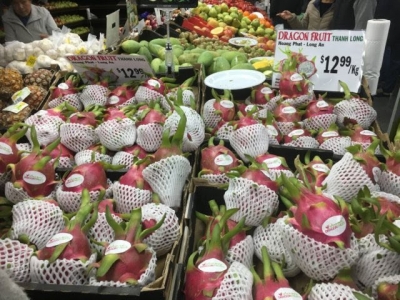Export goods spotlights 2017

Vietnam's agricultural, forestry, and fisheries (AFF) exports have seen spectacular performance in certain product categories and markets, such as processed chicken exported to Japan or dragon fruit to Australia, but some difficulties remain in need of attention from management agencies.
Dragon fruit is sold at around $13 per kilogramme in Autralia
Export of AFF products over $36 billion
Agriculture has made a remarkable contribution to economic growth in 2017. Export value of AFF products hit $36.37 billion, up 13 per cent compared to 2016 and surpassed the target of $32-33 billion.
Notably, the export of fruits and vegetables exceeded rice and rubber to become the key goods for export. Their export turnover hit $3.45 billion, up 40.5 per cent compared to last year, right after cashew nut with $3.52 billion (up 24 per cent). The growth of fruits and vegetables export is the highest in 2017. It is also the first time the export of fishery products has surpassed $8 billion.
After nine years of negotiations, Autralia has approved to import Vietnamese dragon fruit in January. In September, the first batch of dragon fruits of Hoang Phat Fruit Co., Ltd. in Long An were shipped to Autralia.
As many as 32 provinces and cities cultivated dragon fruit on an area of 25,000 hectares and output of 460,000 tonnes per year. Production is concentrated in Binh Thuan, Tien Giang, and Long An. The export turnover of dragon fruit hit $895 million, making up 50.3 per cent of the fresh fruit export turnover.
Since June 2017, Vietnamese chicken can be exported to Japan. Specifically, Japan approved to import the poultry and processed poultry of Koyu & Unitek Co., Ltd. based in Dong Nai. On December 9, 2017, the first 300 tonnes of chicken were officially shipped to Japan. This is a historical milestone of the livestock sector because the Japanese market is very difficult.
Difficulties remain
Vietnamese catfish exports to the US have been shut down since August, after efforts to abolish a programme shifting the regulation of catfish producers to the US Department of Agriculture (USDA) failed. This decision was based on the catfish and Siluriformes fish inspection programme, according to the Farm Bill. If they fail to meet US standards, Vietnamese catfish may face a high risk of losing this export market from March 2018.
Additionally, the domestic price of some goods has also been fluctuating in 2017. The price of steel in August and September increased to VND14.5 million ($640) per tonne, the highest price in the last eight years. The price of hot-rolled steel was $590-620 per tonne, while it was $420-450 in the previous months.
At the end of December 2017, the price of Chinese steel was raised by 43 per cent compared to the beginning of the year due to increased global steel demand. Besides, the price of steel materials rose sharply by 31 per cent within two months, to $340 per tonne.
In contrast to the high increase of steel prices, in August, the price of live hogs fell sharply to VND30,000 ($1.3) per kilogramme, the lowest in the last ten years. The fast growth of the livestock sector led to the abundance of supply, while exports were not positive. Vietnam has only exported 120 thousand tonnees of baby pigs to three countries during the year. At the time, the Ministry of Agriculture and Rural Development urged consumers to give priority to eating pork to help farmers overcome difficulties.
MoIT proposes four solutions for 2018
To promote the export and import targets, Minister of Industry and Trade Tran Tuan Anh proposed to carry out administrative procedures from the central to local levels in 2018, as well as perfect the institutional, business, and export climates.
"It is necessary to boost the restructuring of the economy, sectors, and state-owned enterprises. Criterias on competitiveness, the ability to take part in the global value chains, and the effectiveness of investments are the important measures of restructuring," the minister emphasised.
Another solution Minister Tuan Anh raised is to develop the domestic market, fight against smuggling, fake and imitation goods, as well as trade fraud.
The fourth solution of the minister is to strengthen international integration along with specific measures to accelerate free trade agreements between Vietnam and other countries to find out international destinations for Vietnamese goods.
“While implementing our integration commitments, ministries and sectors should co-ordinate closely and effectively through action plans complying with the directions of the government," the minister said.
Related news
 Fruits of labor
Fruits of labor The bar is high, but fruit and vegetable exports are an area of particular potential for Vietnam.
 High-density feed crop planting could reduce weeds, herbicide use
High-density feed crop planting could reduce weeds, herbicide use Planting some feed crops in a grid pattern may limit the need for herbicide use or mechanical weed control.
 Arctic agriculture needs new crops
Arctic agriculture needs new crops Countries in the far north need to cultivate new varieties of crops if they hope to main local food production.